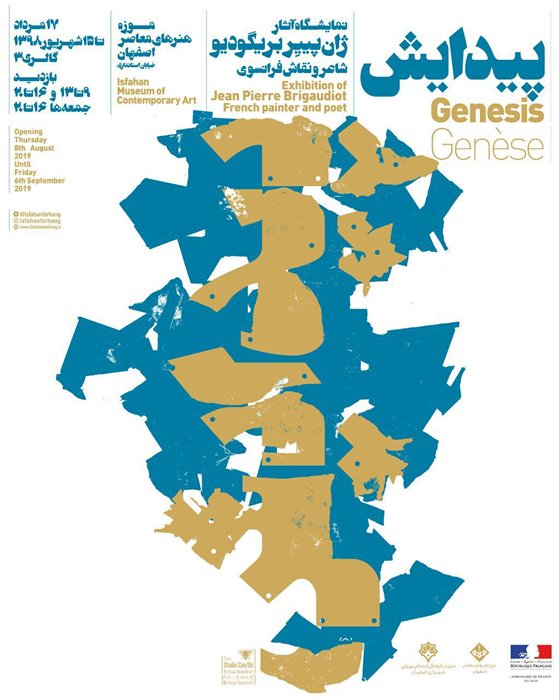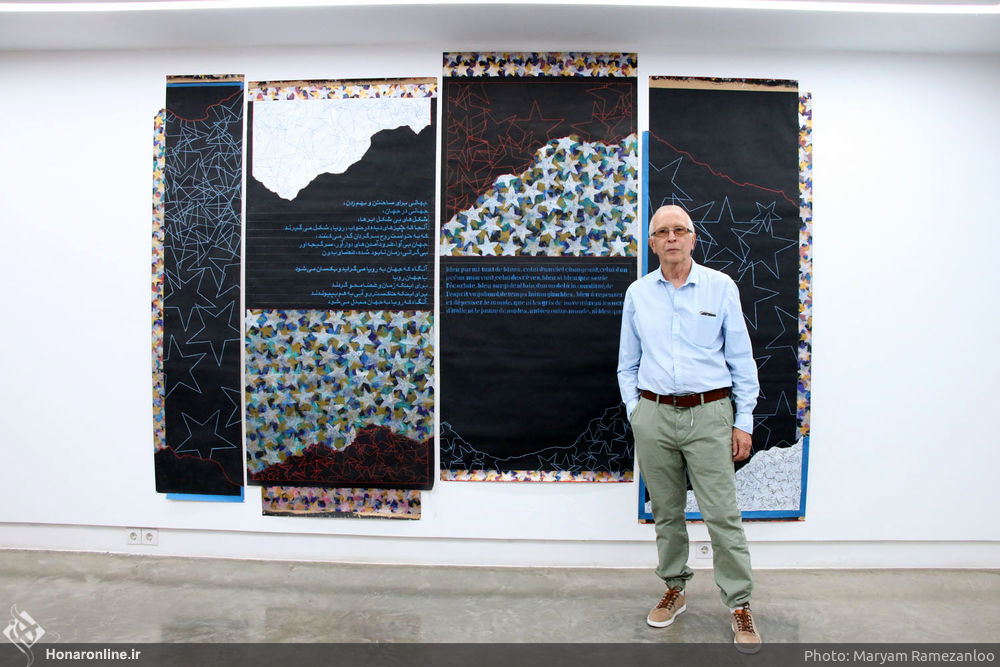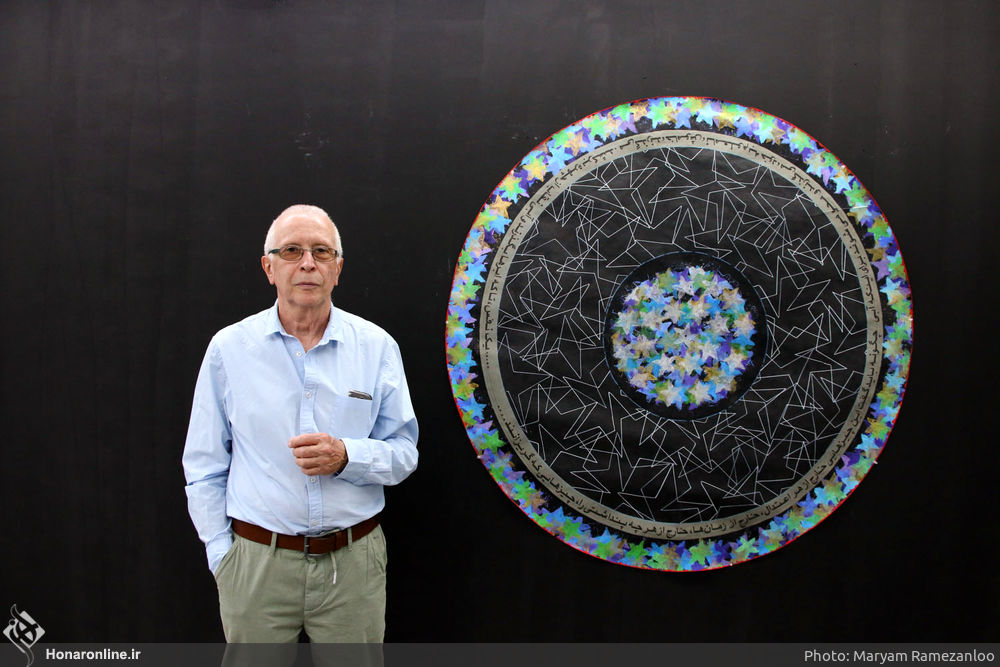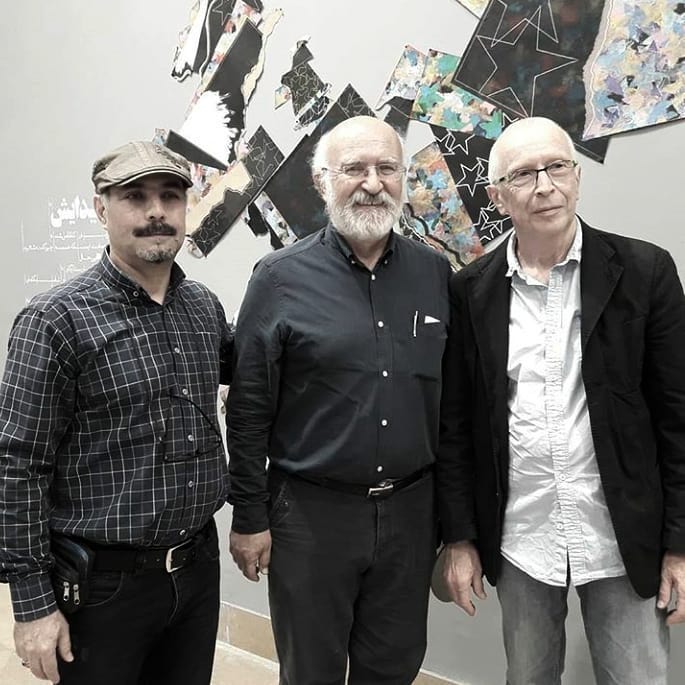“Genesis”
July 7 to September 5, 2019
Analysis by Rasul Moareknejad

Jean Pierre Brigaudiot, a French artist born in 1943, explores poetry, calligraphy, painting, and video. His intertextual, interdisciplinary, and intercultural works reference the six days of creation in religious texts like the Quran. The exhibition’s title, “Genesis,” serves as a threshold to this exploration, with six poems and six visual pieces corresponding to each day.

In the first poem, it is written: “Day One: In the absence of ups and downs / In the rise and fall of a horizon devoid of an east and without reason / In the moment when shadow and light are torn apart, so dark / (To the profound darkness where the soul wanders lost, / Suddenly, a bright light emerges with the innocence of a virgin dawn, / And the sky, so blue / Separates night from day, allowing the inexpressible time / The combative sense and reason / To count and recount endlessly / Beyond what is felt beforehand / Thought and unable to narrate, / The spirit floats on the surface of the waters / To the farthest reaches, beyond / And a reflection, weak, unbearable, and endless, of reality / The clarity of what is / What was / (Poetry: The expression of what language is incapable of / … There was a night and a morning…)”
The poems resonate harmoniously with the beliefs expressed in religious texts, both in their content and in their elegant, poetic style. Accompanying the poems are visual works that each day evoke the emergence of the universe. In this artistic expression, the poems take precedence, followed by the visual elements. These visual works aim to illustrate the dispersion of the universe following the Big Bang, using the elements of water and time to create a complete and unique unity. The visual pieces appear scattered and unconventional, collaged together on the wall. Initially, they present as vertical squares, with several pieces arranged side by side; as one steps back, subsequent images gradually reveal themselves in the form of mythological creatures resembling horses or birds. These fragmented representations of existence serve as manifestations of our contemporary world, transforming into a mental landscape within a unique composition. It is as if the intellect of the noblest of creatures has orchestrated the external world.
On the other hand, the visual works exhibit an interdisciplinary and intercultural manifestation. These works draw from both traditional and modern arts. The traditional aspect refers to the geometry of the grid and the arabesque patterns found in Iranian architecture and art, which are presented alongside the structure and mentality of French culture in their arrangement and composition. These pieces represent two cultures coexisting side by side on the wall, engaging in a dialogue. They serve as a dual reference to a specific time and place, emphasizing both temporal and spatial dimensions—both here and there. In other words, they illustrate the acceptance and transformation of the culture and art of the “other” within oneself, allowing for the visibility of the Iranian culture and art.

A video is also featured in the exhibition, showcasing a blend of poetry written in French and Persian. This combination, along with the arrangement of the visual artworks, illustrates the unity of word and image, as well as the completion of the universe’s creation. Brigaudiot’s works are conceived from a post-structuralist and multidimensional perspective. Like pre-modern artists, he aims to express multiple facets of his creativity, akin to the concept of a “Hakim” in ancient Iran. The artworks are arranged in a straightforward manner that aligns with the artist’s vision, guiding the viewer’s mind through the experience.

Rasoul Moareknejad, Hassan Aghili, Jean Pierre Brigaudiot: 2019 ,Augustr